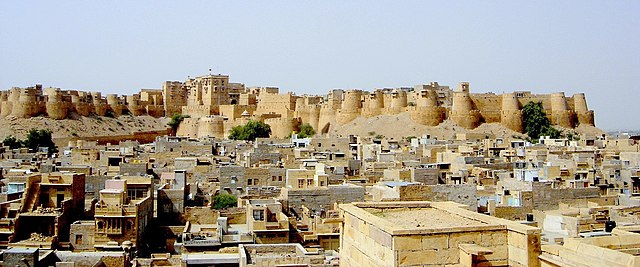Bhati
Rajput clan From Wikipedia, the free encyclopedia
Bhati (also romanised as Bhattī) is a Rajput clan.[1] The Bhati clan historically ruled over several cities in present-day India and Pakistan with their final capital and kingdom being Jaisalmer, India.[2][3]
| Bhati House of Jaisalmer | |
|---|---|
 Coat of arms | |
 Flag of the Kingdom of Jaisalmer | |
| Country | Kingdom of Jaisalmer |
| Founded | 1156 |
| Founder | Rao Bhati |
| Current head | Chaitanya Raj Singh |
| Final ruler | Girdhar Singh |
| Titles | Rawal (later Maharawal) of Jaisalmer |
History
Summarize
Perspective
The Bhatis of Jaisalmer belonged to the Yadava clan of Rajputs.[4][5] They reportedly originated in Mathura through a common ancestor named Rao Bhati, a descendant of Pradyumn.[6][7] According to the seventeenth-century Nainsi ri Khyat, the Bhatis after losing Mathura moved to Bhatner in Lakhi Jungle, and from there to other locations in western and northwestern India including Punjab. Rao Bhati conquered and annexed territories from 14 princes in Punjab, including the area of what is now modern-day Lahore.[8][9] He is also credited with establishing the modern town of Bathinda in the Lakhi jungle area in the 3rd century.[6] The Bhatis also claim descent through Rao Bhati from the legendary Raja Sálbán.

The Bhati ruler of Tanot, Rao Tannu-ji, utilized his long reign (until 814 AD) to consolidate the Bhatis' expanding strength in western Rajasthan and the eastern Cholistan desert area. He is credited with defeating and destroying the domains of the Varya Rajputs and Langas of Multan. A unified attack against the Tanot Bhatis by the Pathans led by Hussain Shah, together with tribes such as the Langas, Khichis, Khokars (Ghakkars), Johiyas, and others, was successfully driven back under Tannu-ji's leadership.[10] In the 10th century, the Bhati rulers near Multan as well as the Muslim Emir of Multan were eager to assist Jayapala, the Hindu Shahi ruler of Afghanistan, because of the slave incursions into their territories by the rulers of Ghazni. However, Jayapala was unable to conquer Ghazni, and the alliance he had formed quickly fell apart.[11] By the 12th-century, Rohri and Sukkur in the present-day Sindh, Pakistan as well as Pugal and Chohtan in Rajasthan had been incorporated in dominion of the Bhati Rajputs.[12] The Muslim chiefs of Sindh and Multan, as well as other Rajput clans like Panwar, Solanki, and Sodhas, were all at strife with the Bhati rulers by this time.[12] Jaisalmer had a dynasty with a successful line of rulers and this became their center. Bhatner, Pugal, Bikrampur, Barsalpur, Deravar, Maroth, Kehror, Aasnikot, Tanot, Lodhruva and Mamanvahan were some of the fortified settlements that were historically ruled by the Bhati clan or subclans. The Bhati ruler Vijayrao Lanjo ruled a vast empire, He was known as the 'uttara disi bhad kivaad' (the sentinel of the north direction), due to his control over forts and settlements that extended from Ghazni to Gujarat, leading to several conflicts with the invading Muslim tribes.[5] According to epigraphic evidence, Vijayarao Lanjo took the large title of Parambhattaraka Maharajadhiraja Parameshwara (the paramount sovereign, great king of kings, the supreme reality).[10] He was succeeded by his son, Bhojde in 1143.[13] However, Bhojde's uncle Rawal Jaisal Singh colluded with the Ghaznavid chiefs, and Bhojde was killed in the resulting combat. Following Bhojde's death, Jaisal Singh became the head of Bhatis.[14] In general, the Bhatis' interactions with Islamic powers were not entirely harmonious. They had defeated multiple Islamic attacks by the Qaramithas, Ghaznavids, and Ghurids before the end of the 12th century.[15]

Timur invaded India in 1398, when he held a vast empire in the Middle East and Central Asia. He suffered tough resistance in India only from the Bhati ruler, Rai Dul Chand of Bhatner. Rajputs and Muslims fought together against Timur under him but the Bhatner fort was ultimately sacked with the city burnt and laid waste.[16][17] The Rathores, the Balochs, the Dehli Sultans, and eventually the Mughals had all clashed with the Bhati kings.[14] The cities of Kapurthala, Ambala and Batala in Punjab are said to be founded by the Bhati Rajputs. Rana Kapur, an immigrant from Jaisalmer founded Kapurthala in the early 11th-century,[18] Raja Amba of Taoni subclan founded Ambala in the 14th century,[19] whereas Rai Ram Deo founded Batala in 1465.[20] By the same 15th-century, Rao Kelana, a powerful Bhati Rajput ruler of Pugal had expanded his territories up to Bhatinda and Abohar, and was responsible for the death of Rathore ruler Chunda of Marwar. Rao Kelana invaded Dera Ghazi Khan and defeated the Balochs. As part of the peace settlement that followed, Zubeida, the daughter of the Baloch chief Jam Ismail Khan (founder of Dera Ismail Khan), was married to the Bhati ruler.[10] In 1613, Raja Kishan Singh a Rathore ruler and the founder of Kishangarh State complained his brother-in-law Jahangir about a Bhati sardar, Govind Das Bhati for killing of his brother, and thereafter Raja along his followers executed Bhati sardar as per direction of Jahangir. As Govind Das Bhati was a noble affiliated with Rathore ruler Sur Singh, consequently his son Gaj Singh of Marwar killed Raja Kishan Singh.[21]

The historian André Wink states that prior to the Bhatis' expulsion from the country of Zabulistan, they reportedly inhabited as far as Samarkand in Uzbekistan.[22] The Bhatis claim to be the ancestors of the Chughtai Mughals. The historian Tanuja Kothiyal notes that a part of such claims may well be justified.[5] The Phulkian dynasty claimed direct descent from Rawal Jaisal Singh, the Bhati Rajput founder of the Kingdom of Jaisalmer.[23][24]
Culture and ethos
The greeting used by Bhati Rajputs is Jai Shri Kishan ("victory to Lord Krishna") as opposed to the general Rajput greeting Jai Mata Jiri ("victory of the Mother Goddess").[25]
Dulla Bhatti was a Punjabi landlord who led a revolt against Akbar.[26] He remains Punjab's folk hero and is made the centrepiece of all Lohri songs.[27]
References
Bibliography
Wikiwand - on
Seamless Wikipedia browsing. On steroids.
